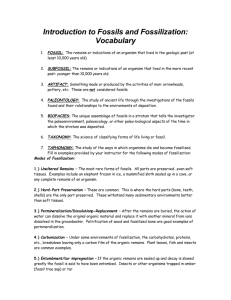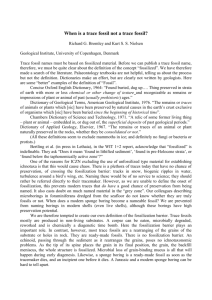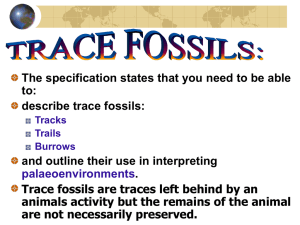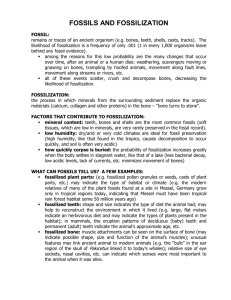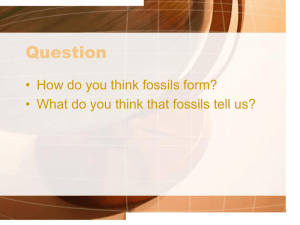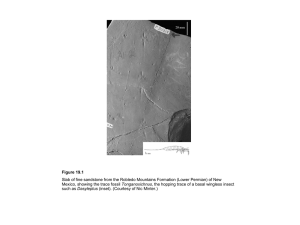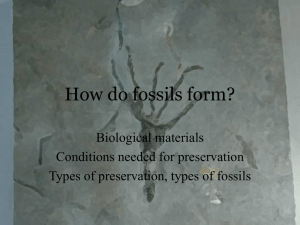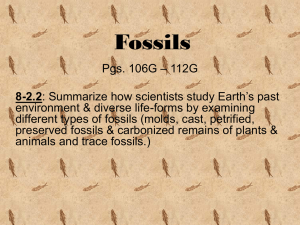4 Fossils and Fossilization
advertisement
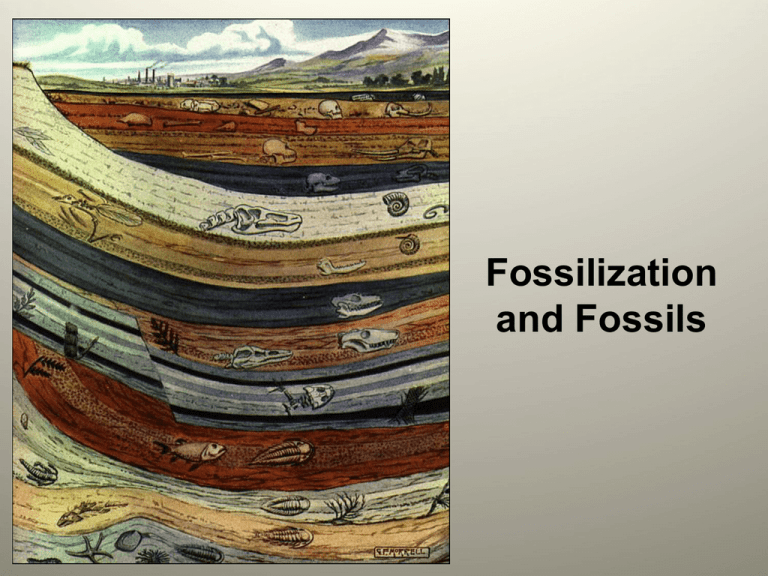
Fossilization and Fossils So what exactly is a fossil? ANY evidence of ancient life. Body fossil teeth or bones Trace fossil cast, track, burrow Next question… What is a scientist who studies fossils called? paleontologists Archaeologists study the remains of ancient humans and their cultures. Write this down; it is an IMPORTANT distinction! Fossils • If the layers of sedimentary rock are the pages that tell the story of the Earth, fossils are the words. • Literally, the word fossil means “dug up”. • Technically speaking fossils are remains of life that are at least 15,000 years old. • Preservation can include both altered and unaltered hard and soft parts. Fossils can also be casts and molds. • Found in shales, sandstones, limestones, amber, ash, nodules, tar, and ice. • The study of an organism from death to fossilization is called taphonomy (can include post-fossilization events as well). Process of fossilization Process of fossilization Fossilization depends on two critical steps: • rapid burial by sediment • mineralization Helpful conditions: • anoxia (lack of oxygen following burial) • minimal disturbance subsequently • mineral-rich water in sediment Types of Fossilization Unaltered Remains Original material, including soft parts preserved Rapid burial in ice, tar, or mummification Recrystallization Original material dissolved New mineral deposited simultaneously Permineralization Minerals infill pores and holes Molds and casts Infilling with other material Often, sedimentary infill Carbonization Preservation as thin films of carbon Outline and sometimes detailed structures preserved Unaltered Soft Parts (Amber) Scorpion Feather Mosquito Unaltered Soft Parts (Ice) “Blue Babe” bison Siberian Wooly Mammoth Unaltered Hard Parts: Tar and Anoxic Silt LaBrea Tar Pit Avitelmessus, NC Beetle in tar Fish from Messel, Germany Unaltered Hard Parts (skeletal) Smilodon Ashfall Park Columbian Mammoth Pliocene Recrystallization: Aragonite to Calcite Pterorhytis conradi Chesapecten jeffersonius Eocene Cretaceous Busycon carica Urosalpinx sp. Polinices sp Athleta petrosus Recrystallization: Change in Crystal Structure Cyclonema Euproops Mississippian Crinoids Edrioasteroid Dalmanites Carbonization Knightia Opabinia Spider Dragonfly larva Canadia Carbonization Sphenopteris Permineralization Petrified Wood Brazil Jurassic Pinecone Dinosaur Bone Shark Teeth Permineralized Dinosaur Bone: Cell Structure Preserved Altered Hard Parts (replacement) Silicified Mollusks Pyritization Silicified Stromatolite Molds and Casts shell cast external mold shell dissolves sediment infilling interior shell shell Sediment fills void steinkern Shell dissolves Casts and Steinkerns Trace Fossils • Reflect the activity, or behavior, of organisms on land and in marine settings. • Exogenic – on the surface. • Endogenic – within the substrate. • Shape of the trace fossil does not always mirror the animal. • Trace fossils are named for their particular shape and form and not for the animal that made the trace. Same animal may make several different types of trace fossils. Trilobite resting trace Trilobite trackway Grazing trace • Other trace fossils include trackways on land (mostly dinosaur, reptile, and amphibian) and coprolites (fossilized feces, “poop”). Dinosaur Ridge, CO Glen Rose, TX Coprolites Dinosaur Turtle Mammal Crocodile Factors that Affect Fossilization
